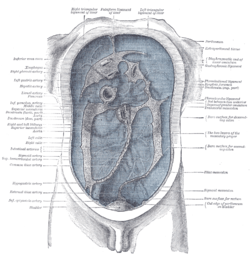Sigmoid mesocolon
| Sigmoid mesocolon | |
|---|---|
 | |
| Diagram of the abdominal GI tract, highlighting the colon. | |
 | |
| Diagram showing the lines along which the peritoneum leaves the wall of the abdomen to invest the viscera (sigmoid mesocolon labeled at bottom right, third from the bottom) | |
| Latin | Mesocolon sigmoideum |
| Gray's | subject #246 1157 |
The sigmoid mesocolon is the fold of peritoneum which retains the sigmoid colon in connection with the pelvic wall.
Its line of attachment forms a V-shaped curve, the apex of the curve being placed about the point of division of the left common iliac artery.
The curve begins on the medial side of the left psoas major, and runs upward and backward to the apex, from which it bends sharply downward, and ends in the median plane at the level of the third sacral vertebra.
The sigmoid arteries and sigmoid vein as well as the superior rectal artery and vein run between the two layers of this fold.
This binds the large intestine to the posterior abdominal wall.
It also carries blood and lymphatic vessels to the intestines.
Together, the mesentery and mesocolon hold the intestines loosely in place, allowing movement as muscular contractions mix and move the luminal contents along the gastrointestinal tract.
References
This article incorporates text from a public domain edition of Gray's Anatomy.
External links
- 37:13-0302 at the SUNY Downstate Medical Center - "Abdominal Cavity: The Colon and its Divisions"
- SUNY Anatomy Image 8184
Additional Images
-
Mesenteric relation of intestines. Deep dissection. Anterior view.
-
Mesenteric relation of intestines. Deep dissection. Anterior view.
| ||||||||||||||||||||||||||||||||||

